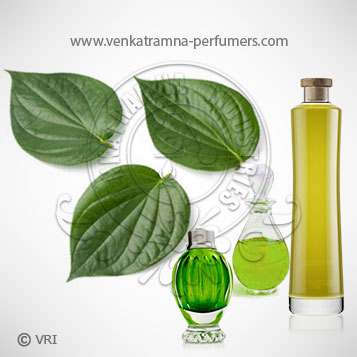
| Botanical Name | Piper betle |
| Common Name | Copticum, Betel Leaf Oil, Carum Copticum, Paan. |
| Country of Origin | India |
| Solubility | Soluble in alcohol and oils. Insoluble in water. |
| Specific Gravity | 0.958 – 1.044 @ 20°C |
| Optical Rotation | (-) 1.5 To (-) 4 |
| Refrective Index | 1.500 To 1.5240 |
| PlantPart | Leaves |
| Bland With | Lavender, Eucalyptus, Tea Tree, Rosemary & Cardamom. |
| CAS No | 84775-81-5 |
| Flash Point | Not Applicable |
| Extraction Method | Steam Distillation |
Betel Leaf Oil is derived from Betal Leaf plant leaves that yield this aromatic essential oil. The heart-shaped leaves have distinct pleasant aroma & are commonly chewed alone or with other plant materials. Betel leaf oil derived from betel leaf plant leaves that yield this aromatic essential oil. The heart-shaped leaves have distinct pleasant aroma and are commonly chewed alone or with other plant materials. The betel which includes pepper and kava. Betel leaf is mostly consumed Asia, and elsewhere in the world by some Asian emigrants, as betel quid or in paan with Areca nut and/or tobacco.
The Betel Leaf plant grows widely over the entire area between South Arabia and Southeast China. In India, Betel Leaf has historically been chewed to sweeten the breath and preserve the teeth. In Sri Lanka and in many parts of India a sheaf of betel leaves is traditionally offered as a mark of respect and auspicious beginnings. Occasions includes, greeting elders at weeding ceremonies, New Year, offering payment to Ayurvedic physicians and astrologers where usually money and/or areca nut are kept on top of the sheaf of leaves and offered to the elders for their blessings. The betel leaf is cultivated mostly in India farmers called barouj prepare a garden called a barouj in which to grow betel. the barouj is fenced with bamboo sticks and coconut leaves. The soil is plowed into furrows of 10 to 15 meters’ length, 75 centimeters in width and 75 centimeters’ depth. Oil cakes manure, and leaves are thoroughly incorporated with the topsoil of the furrows and wood ash. The cutting is planted at the beginning of the monsoon season.
Color : Clear yellow to dark brown liquid with creosote-like odor,
Aroma : Distinctly phenolic smoky note, almost tar-like. A compound tentatively identified as chevibetol is believed to have the greatest impact on the characteristic smoky aroma of betel leaf.
Cadinene-1-2, Cadiniol-1-2, Decanal-2-3, Dodecanol-4-5, Eugenol-30-35, Isoeugenol-10-12, Geraniol-2-3, Linalool-1-2, Myrcene-2-3, Methyl Benzoate-2-3, Sabinene-5-7, Safrole-6-8, Alpha-Terpineol-2-3, Gamma-terpinene-1.5-2, Thujene-1-2, Ocimene-1-2. The minor components with 0.5-1% are Gamma-Elemene, Caryophyllene oxide, Terpinolene, Costol, Camphene, Hexadecanoic acid.
The betel leaf essential oil is valued in Ayurveda for its stimulating, carminative, aromatic, antiseptic, warming and aphrodisiac properties. It has several medicinal applications among natives and is especially used to harden gums, preserve teeth and sweeten breath. It also improves voice and is reputed aphrodisiac.